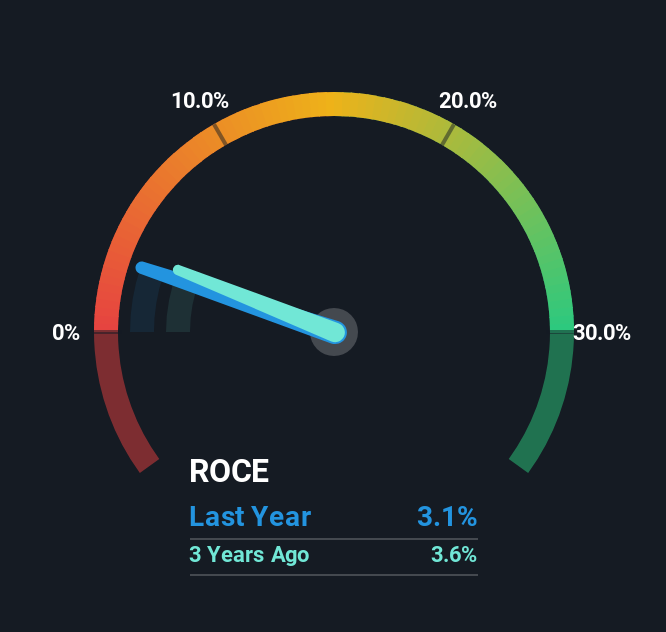Returns On Capital Are Showing Encouraging Signs At Nippon Sheet Glass Company (TSE:5202)
There are a few key trends to look for if we want to identify the next multi-bagger. Firstly, we'd want to identify a growing return on capital employed (ROCE) and then alongside that, an ever-increasing base of capital employed. Ultimately, this demonstrates that it's a business that is reinvesting profits at increasing rates of return. With that in mind, we've noticed some promising trends at Nippon Sheet Glass Company (TSE:5202) so let's look a bit deeper.
Understanding Return On Capital Employed (ROCE)
For those that aren't sure what ROCE is, it measures the amount of pre-tax profits a company can generate from the capital employed in its business. Analysts use this formula to calculate it for Nippon Sheet Glass Company:
Return on Capital Employed = Earnings Before Interest and Tax (EBIT) ÷ (Total Assets - Current Liabilities)
0.031 = JP¥19b ÷ (JP¥1.0t - JP¥391b) (Based on the trailing twelve months to June 2025).
So, Nippon Sheet Glass Company has an ROCE of 3.1%. In absolute terms, that's a low return and it also under-performs the Building industry average of 7.7%.
View our latest analysis for Nippon Sheet Glass Company

Above you can see how the current ROCE for Nippon Sheet Glass Company compares to its prior returns on capital, but there's only so much you can tell from the past. If you'd like, you can check out the forecasts from the analysts covering Nippon Sheet Glass Company for free.
What Does the ROCE Trend For Nippon Sheet Glass Company Tell Us?
Nippon Sheet Glass Company has broken into the black (profitability) and we're sure it's a sight for sore eyes. The company was generating losses five years ago, but has managed to turn it around and as we saw earlier is now earning 3.1%, which is always encouraging. Interestingly, the capital employed by the business has remained relatively flat, so these higher returns are either from prior investments paying off or increased efficiencies. That being said, while an increase in efficiency is no doubt appealing, it'd be helpful to know if the company does have any investment plans going forward. So if you're looking for high growth, you'll want to see a business's capital employed also increasing.
For the record though, there was a noticeable increase in the company's current liabilities over the period, so we would attribute some of the ROCE growth to that. Essentially the business now has suppliers or short-term creditors funding about 39% of its operations, which isn't ideal. It's worth keeping an eye on this because as the percentage of current liabilities to total assets increases, some aspects of risk also increase.
What We Can Learn From Nippon Sheet Glass Company's ROCE
As discussed above, Nippon Sheet Glass Company appears to be getting more proficient at generating returns since capital employed has remained flat but earnings (before interest and tax) are up. And investors seem to expect more of this going forward, since the stock has rewarded shareholders with a 42% return over the last five years. With that being said, we still think the promising fundamentals mean the company deserves some further due diligence.
While Nippon Sheet Glass Company looks impressive, no company is worth an infinite price. The intrinsic value infographic for 5202 helps visualize whether it is currently trading for a fair price.
While Nippon Sheet Glass Company isn't earning the highest return, check out this free list of companies that are earning high returns on equity with solid balance sheets.
Valuation is complex, but we're here to simplify it.
Discover if Nippon Sheet Glass Company might be undervalued or overvalued with our detailed analysis, featuring fair value estimates, potential risks, dividends, insider trades, and its financial condition.
Access Free AnalysisHave feedback on this article? Concerned about the content? Get in touch with us directly. Alternatively, email editorial-team (at) simplywallst.com.
This article by Simply Wall St is general in nature. We provide commentary based on historical data and analyst forecasts only using an unbiased methodology and our articles are not intended to be financial advice. It does not constitute a recommendation to buy or sell any stock, and does not take account of your objectives, or your financial situation. We aim to bring you long-term focused analysis driven by fundamental data. Note that our analysis may not factor in the latest price-sensitive company announcements or qualitative material. Simply Wall St has no position in any stocks mentioned.
About TSE:5202
Nippon Sheet Glass Company
Engages in the manufacture and sale of glass and glazing products in Japan, Europe, North America, and South America.
Undervalued with moderate growth potential.
Similar Companies
Market Insights
Community Narratives




